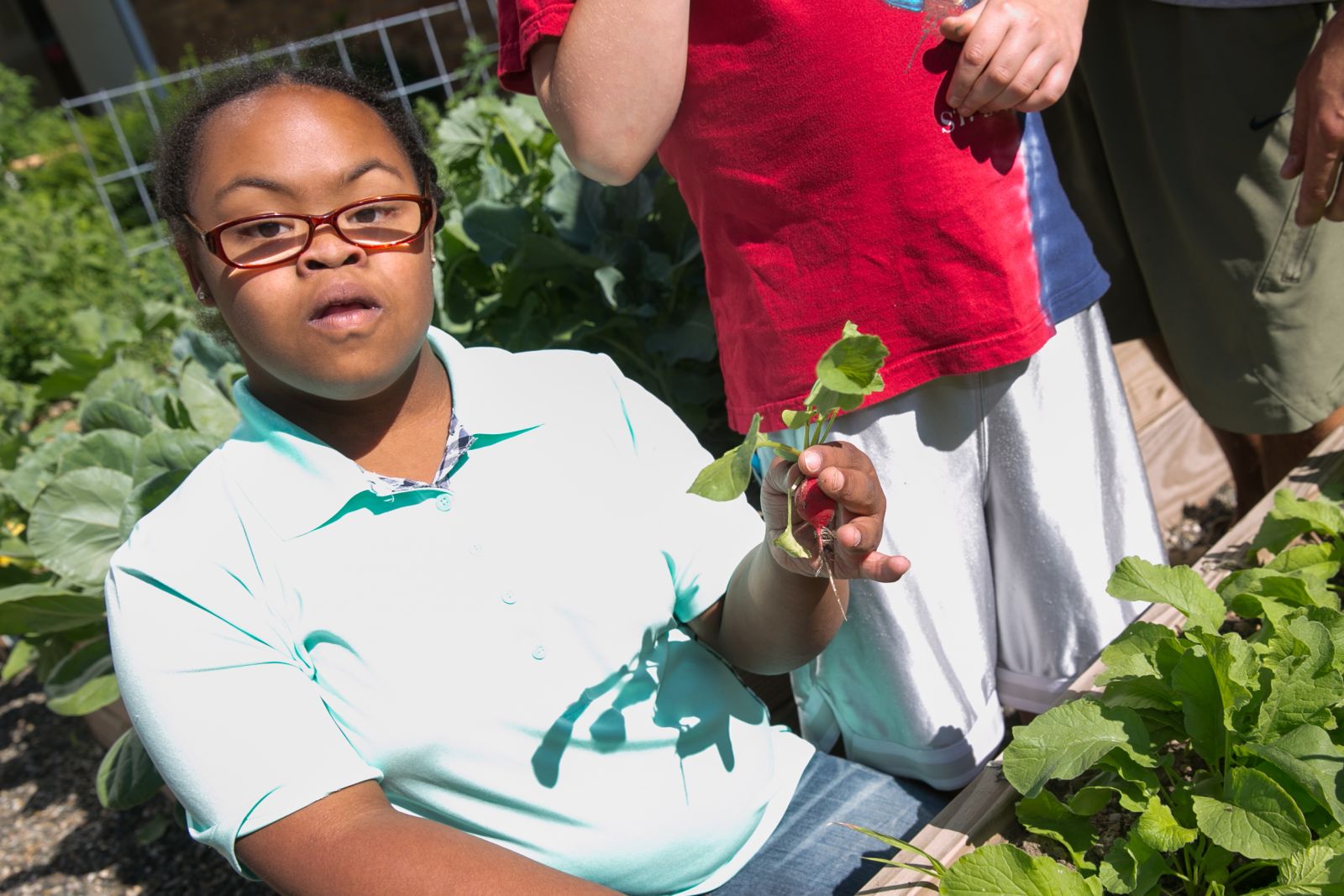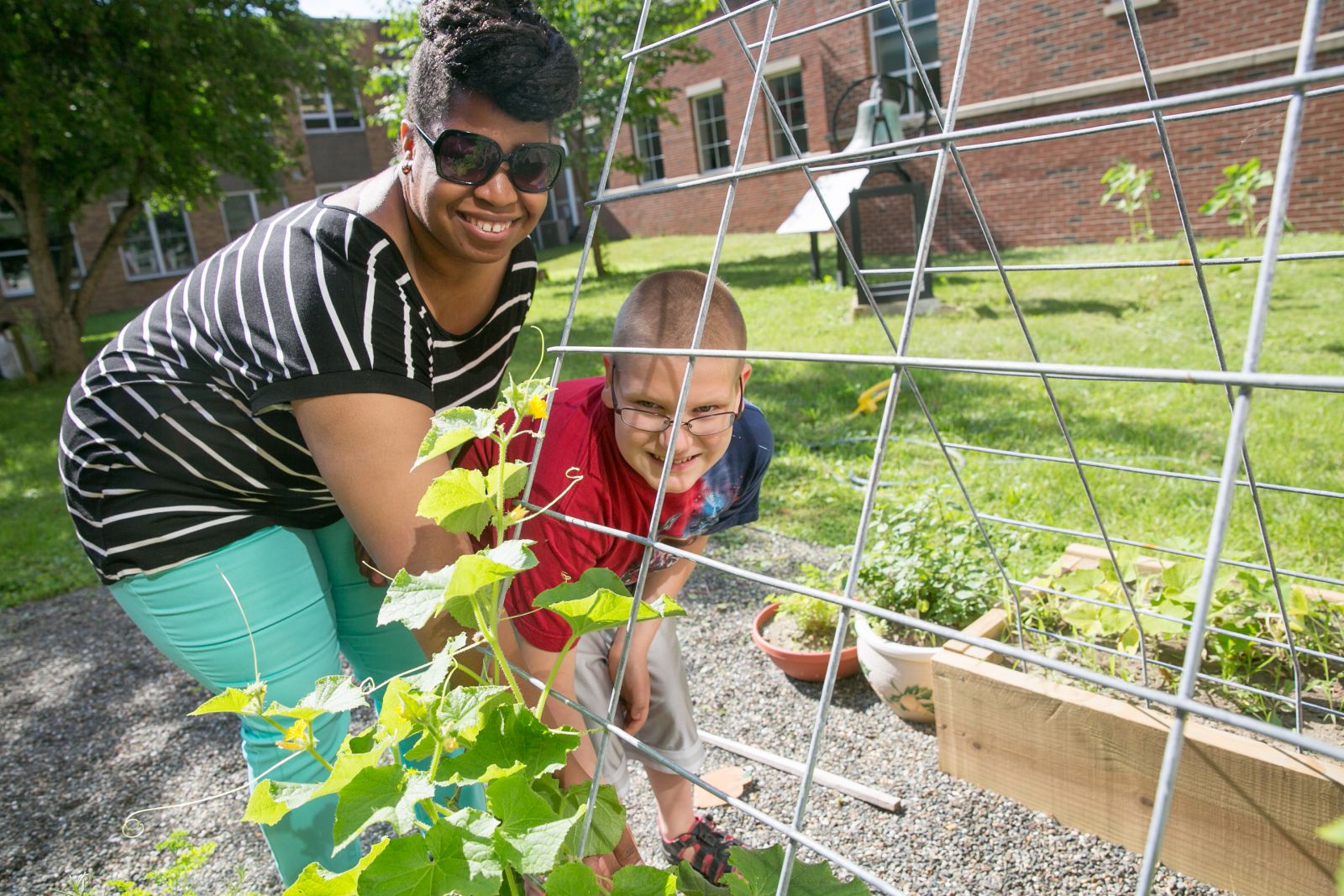Left to right, front row, Collin Parent, Emily Dowd, Conner Riano, Abby Tefoe, Whitney Newell, Matt Spain. Back row, Juaneika Agyeman, Diane Murray, Lindsey Gibson and Eric Jasuta.
In what was once an abandoned, enclosed courtyard surrounded by the four brick walls of Knickerbacker School in Lansingburgh, there is now a hotchpotch of horticulture.
Every morning, it’s rise and shine for the produce in Knight’s Kale Garden — so named after the school’s mascot, a knight on a steed, and the rippled kale vegetable. The walls of the school keep out any tormenting winds or natural predators that could threaten a garden.
But, while it’s enclosed, it’s not a secret garden by any stretch. That’s because students are out there learning, raking, weeding, mulching and learning under the nourishing sun and the many guiding hands of their teachers. There are now six raised beds of vegetables.
Middle school teacher Lindsey Gibson, a member of the Lansingburgh Teachers Association, says the garden is used for project-based learning for math: calculating the amount of topsoil needed for the garden beds; figuring out the amount of pea stones needed to keep out weeds; measuring the space in the garden beds to determine how many plants each could accommodate.
In technology class, the students learned how to cut lumber and use a saw to build the beds.
Children are learning about nutrition: In November, for a turkey feast at the school, they made spaghetti squash casserole. They also bring their bounty to the cafeteria, where it is cooked for students. Crops include broccoli, squash, tomatoes, cucumbers and herbs.
“When I started this four years ago, I’d never grown a thing in my life,” Gibson said. “We’ve had to do research along with the kids.”
She and the other teachers involved volunteer their time to keep the garden thriving in the summer, as well as before and after school during the academic year.
“It’s all volunteer,” said Gibson.

Whitney Newell, 7th grader at Knickerbacker Middle School, picks a fresh radish to try.
Families help out through a schedule for weeding and picking.
The garden is one oasis in Lansingburgh, a lean but once-thriving village in Troy. Economically challenged, it is a place, as some people bemoan, that makes the news not for good things.
After the garden became successful, teachers worked on sharing news about it with the community and the media; they focused on the positive things about Lansingburgh.
A good garden brings life, as do those who care about people and place, such as those who preserve the village’s rich history or put on the Memorial Day Parade each year. This Rensselaer County town was once home to brush factories and oil clothe factories. Shirts and collars were manufactured here, and pottery and decorative tin ware were also produced.
But the sun never sets on hope. And it sends vegetables up through the dirt and into the light. They, in turn, pollinate the education of students here.

Conner Riano, 7th grade student at Knickerbacker Middle School, checking on the beans with 7th grade teacher Juaneika Agyeman.
Special education teacher Juaneika Agyeman, who confesses she is “notoriously afraid of bugs,” uses the garden to teach ELA. Her students created press badges and interviewed other students and teachers who work in the garden. The interaction helped them hone socialization skills, such as speaking clearly and making eye contact. Afterward, they wrote articles about their findings. Incorporating technology, they designed a garden newsletter and a drive to upload it.
Surveying the summer crops, TA member Agyeman said, “Growing up in a city, this gave me insight into just what it takes, from beginning to end. I feel like I’ve grown personally.”
“A lot of the kids had no idea what things grew,” said Robinson. They didn’t know about many of the gifts of the ground.
Teacher Eric Jasuta, who is also a member of the Lansingburgh TA, brought in his juicer from home, and whipped up concoctions made of kale, spinach, mint, apples and beets. During the school year, he used the garden as part of his social studies class, teaching students the history of gardening and how Native Americans farmed.
Next, he will help students grow corn and perhaps soy beans, against the back wall.
“They are learning manual labor and landscaping,” he said.
And then there’s the science: pollination, seeds, photosynthesis, and ecosystems. They’re learning how the honeybees are at risk and how that affects blueberries, corn and wheat. Thirty gardening students took a field trip to a farm in Kinderhook, where they took part in an educational program.
The students have planted a circle of golden sunflowers and are making a teepee of the bright, tall flowers so they can read in the shade. Perhaps they might read Moby Dick, written by the renowned author Herman Melville who lived for a time in Lansingburgh, which is home to the historic Melville House. They might read about Chester Arthur, the 21st president of the U.S., who local historians say lived in Lansingburgh for part of his youth.
For the summer, Gibson set up a program called Remind 101 with a text alert schedule for families who help weed and pick vegetables so they can have fresh product at their table.
“We come out here and pick stuff,” said parent Matt Spain, holding a bag of radishes and another of peas.
Student Abby Tefoe said she plants and weeds. Her favorite vegetable? “The cucumbers!”
“It’s important they find out where food comes from,” said her father, Wayne Tefoe, Sr.
“One of the best parts is that kids come here over the summer. They get to harvest the vegetables and go home and cook with their families,” Gibson said. “One child used fresh basil to make meatballs. Another student made a zucchini bake with all of our different zucchinis. They try new vegetables.”
Blueberry and blackberry bushes, along with a strawberry patch, are in the plans for next year. The colors — and the tastes — will provide more gardening pleasures.
Flanking one school wall is a new greenhouse. High school students in the residential structures program, led by teacher Adam South, helped build the 70-square foot greenhouse with shelving to grow herbs and seedlings. It is also used to store tools.
The project was made possible with a $2,000 Toolbox for Education grant for the 2014-15 school year from the Lower’s Charitable and Educational Foundation. (ToolboxForEducation.com). Money from the grant was also used to purchase seedlings, soil and gardening tools. Lansingburgh was one of 500 schools to receive the Lowe’s grant.
Knickerbacker School is a middle and high school combined. Eileen Culliton leads the local TA.
-- Liza Frenette